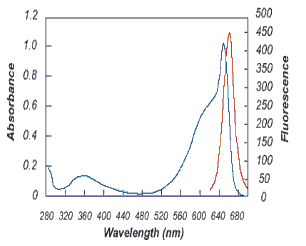 全部商品分类
全部商品分类
APC (Allophycocyanin) a highly soluble and fluorescent protein, belongs to the phycobiliprotein family derived from cyanobacteria and eukaryotic algae. APC is made up of alpha and beta subunits and is present as a trimer (αβ)3The trimer is unstable and susceptible to dissociation at low concentrations. The monomer, αβ, has a lower fluorescence quantum yield compared to the trimer and the maximal absorption is shifted to 620 nm. The chemically crosslinked APC trimer is much more stable than the native protein, but still retains comparable spectroscopic properties.
APC is an ultra-sensitive fluorescent tracer because of its high emission quantum yields. Its near-infrared fluorescence is relatively free of interference from the autofluorescence of cellular components and other biological materials. It is significantly more sensitive than conventional organic fluorophores and has been used in applications such as flow cytometry, homogeneous FRET assay and immunoassays.
The extinction coefficient of CL-APC at 650 nm is 700,000 cm-1M-1. CL-APC is suppliedin sodium phosphate buffer, pH 7.0 with ammonium sulfate. The protein is very stable and can be stored for years in this buffer.
Before use, centrifuge the CL-APC suspension at 10,000g for 10 min at 4℃. Discard the supernatant and resuspend the pellet (CL-APC) into the desired buffer. Desalt the sample using either Sephadex G-25 or dialysis. Store CL-APC at 4℃ and keep away from light.



参考图片
Maximum absorption: 650±5 nm; Maximum emission: 660±5 nm; Fluorescence quantum yield at 660±5 nm:







 用小程序,查商品更便捷
用小程序,查商品更便捷




